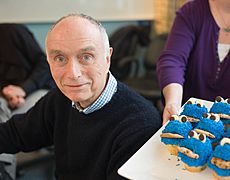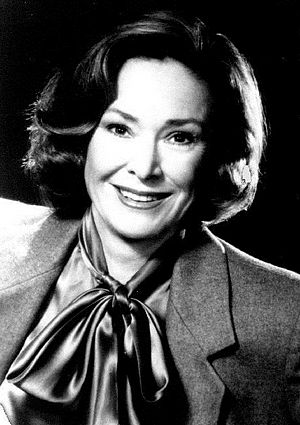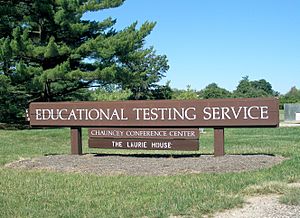History of Sesame Street facts for kids
Sesame Street is a popular TV show for young children that first aired on November 10, 1969. It's still going strong, reaching its 51st season in 2020! This show has always tried to keep up with new ideas about how children learn and grow, and how important it is to show different cultures.
The show is famous for its fun Muppets created by Jim Henson, along with cartoons, short films, humor, and even celebrity guests. It was the first TV show to use careful research to create its content and make sure it was teaching kids effectively. From the start, people loved the show, and it quickly became very popular. By 2009, Sesame Street was shown in over 120 countries, and 20 different versions were made around the world. It has won many awards, including eleven Grammys and over 150 Emmys – more than any other children's show!
The idea for Sesame Street began in 1966 when TV producer Joan Ganz Cooney and Carnegie Corporation vice president Lloyd Morrisett talked about making a new kind of children's show. They wanted to use the power of television to help young children get ready for school. After two years of research, their new group, the Children's Television Workshop (CTW), received $8 million to create the show.
By 1979, ten years after it started, nine million American children under six watched Sesame Street every day. Studies showed it was really helping kids learn. The show's team grew, hiring more women and people from different backgrounds. In 1981, the government stopped funding the show, so the CTW found other ways to make money, like through magazines, books, toys, and international sales. In the 1980s, Sesame Street started teaching about feelings, relationships, and good behavior. Many stories came from the real lives of the cast and crew, like when Will Lee, who played Mr. Hooper, passed away, and when Luis and Maria got married.
In recent years, Sesame Street has faced new challenges, like how kids watch TV differently now and more competition from other shows. After the year 2000, the show changed its format from short, separate segments to more connected stories. Because the Muppet Elmo became so popular, the show added a special part called "Elmo's World". In 2015, Sesame Street started airing new episodes first on HBO, a cable channel. These episodes then became available on PBS nine months later. By its 50th anniversary in 2019, Sesame Street had made over 4,500 episodes, 35 TV specials, 200 home videos, and 180 albums. Its YouTube channel had almost 5 million subscribers, and the show had 24 million followers on social media.
Contents
Why Sesame Street Was Created
In the late 1960s, almost all American homes had a TV, and young children watched about 27 hours of TV each week. But many people thought the shows for kids were too violent or focused too much on selling things. Producer Joan Ganz Cooney called children's TV a "wasteland," and many agreed. Most kids' shows back then were made by local stations without much thought for teaching or showing different cultures. Using TV as a learning tool was a new and exciting idea!
Experts like Edward Palmer and Shalom M. Fisch noted that children's TV shows in the 1950s and 1960s often just copied older forms of media. For example, they might show simple camera shots of kids playing or just pictures from storybooks. The hosts of these shows were often seen as talking down to children. One exception was Captain Kangaroo, which was slower-paced and more thoughtful.
Research about early childhood education showed that when children were ready for school, they did better and learned more easily. Children from families with less money often had fewer resources to prepare them for school. Studies also showed that children from low-income and minority backgrounds often scored lower in school-related skills. At the same time, the study of developmental psychology was growing, and scientists realized that helping children learn early could really boost their brain growth. Because of these new ideas and big changes happening in the United States, it was the perfect time for a show like Sesame Street to be created.
How Sesame Street Began (1966–1969)
The First Ideas
"What if? became their operative phrase. What if you could create content that was both entertaining and instructive? What if it went down more like ice cream than spinach?"
In early 1966, Joan Ganz Cooney, who had won an Emmy for a documentary about poverty, hosted a dinner party. Among her guests was Lloyd Morrisett, an experimental psychologist who helped fund Sesame Street. Morrisett and the others believed that even with limited money, TV could reach millions of children effectively.

A few days later, Cooney and Morrisett met to plan how to use TV's power for good. Morrisett hired Cooney to research child development, education, and media, even though she didn't have much experience in education. She traveled across the U.S. and Canada, talking to experts and writing a report about her findings.
Cooney's report, "The Potential Uses of Television for Preschool Education," explained how TV could help young children, especially those from low-income families, get ready for school. The show focused on helping disadvantaged children, but Cooney and the creators also wanted it to be fun and helpful for all children, no matter their background. They wanted to make the show so appealing that inner-city children would learn just as much as kids with more learning opportunities.
Cooney suggested using public TV, even though it hadn't been great at reaching inner-city audiences. She thought they should use TV's "most engaging traits," like high-quality production, clever writing, and good animation, to reach as many people as possible. As one critic said, "If [children] could recite Budweiser jingles from TV, why not give them a program that would teach the ABCs and simple number concepts?" Cooney also wanted the show to encourage parents and older siblings to watch, so she suggested including humor for adults. She believed that celebrity guests and cultural references would also make families watch together.
Using Research to Create the Show
Sesame Street was the first children's TV show to use a clear learning plan with goals that could be measured. It was also the first to use research to design its content. Research for Sesame Street had three main jobs: to see if kids liked the show, to figure out how to make it even better, and to tell the public and investors about the show's impact. About 10-15% of the show's first budget of $8 million was spent on research, and researchers were always in the studio during filming. A "Writer's Notebook" helped writers and producers connect the show's learning goals with the scripts. For example, Oscar the Grouch was created to teach children about both positive and negative emotions. This teamwork between researchers and producers, and the idea of using TV for education, became known as the "CTW model."
The creators of Sesame Street believed that TV could teach if it could grab and keep children's attention. Edward Palmer, the CTW's first Director of Research, was a key person in this. He developed a special test called "the distractor" to see if the show kept young viewers interested. Two children would watch an episode on a TV while a slide show played next to it. The slides changed every seven seconds, and researchers watched to see when the children looked away from the show. If the episode kept their interest 80-90% of the time, it would air. If it was only 50%, they would reshoot it. By the fourth season, episodes almost always scored above 85%.
Testing Episodes in 1969
Before Sesame Street officially started, producers made five one-hour test episodes in July 1969. These were shown to preschoolers in homes and daycares in Philadelphia and New York City. The results were very good: children learned from the shows, liked them, and stayed focused for the whole hour. However, researchers noticed that while kids loved the Muppet parts, their interest dropped during the "Street" scenes when only human actors were on screen. This happened because child psychologists had worried that children would be confused if humans and Muppets were shown together.
The "Street" scenes were important because they tied the whole show together. So, the producers knew they had to make big changes. They decided to ignore the experts' advice and reshoot the Street segments. Jim Henson and his team created Muppets that could interact with the human actors, like Oscar the Grouch and Big Bird, who became two of the show's most loved characters. This decision was a turning point for Sesame Street, leading to the famous mix of "fluffy monsters and earnest adults."
First Season and Premiere (1969–1970)
Sesame Street officially premiered on November 10, 1969. It was widely praised for being original and was loved by both parents and children. The show quickly became popular, with 1.9 million homes and 7 million children watching it every day. In its first season, studies showed that children who watched the show often scored higher on tests than those who watched less.

In November 1970, Big Bird was on the cover of Time magazine because he received more fan mail than any of the human hosts! The magazine called it "not only the best children's show in TV history, it is one of the best parents' shows as well." An executive from ABC said the show brought "taste and wit and substance" to children's TV. Sesame Street won a Peabody Award, three Emmys, and the Prix Jeunesse award in 1970. Even President Richard Nixon sent a congratulatory letter!
"Sesame Street is ... with lapses, the most intelligent and important program in television. That is, not anything much yet."
Not everyone loved Sesame Street at first. In May 1970, a state commission in Mississippi voted not to air the show because of its integrated cast. This decision made national news, and the commission quickly changed its mind.
The show's producers made some changes in the second season. They made segments with children more natural and spontaneous. Since the show used government money, more groups wanted to see themselves represented. For example, Hispanic groups criticized the show for not having enough Latino characters. The CTW responded by hiring Hispanic actors, staff, and researchers. By the mid-1970s, the show included Chicano and Puerto Rican cast members, films about Mexican holidays, and cartoons that taught Spanish words.
Women's groups also felt the show needed to be less focused on male characters. For example, the character Susan was originally a housewife. They also wanted more strong female Muppets. The show's producers responded by making Susan a nurse and hiring a female writer.
The 1970s: Growing and Changing
By the mid-1970s, Sesame Street had become a big part of American culture. Two important studies in 1970 and 1971 showed that the show really did help children learn. These results helped the show get more funding for years to come. Studies found that the more children watched Sesame Street, the better they understood the lessons.
Jon Stone, a producer, was very important during these years. He helped guide the show and was known for finding and supporting talented people, especially women, in TV production. Many women he hired went on to lead children's programming at channels like Nickelodeon, the Disney Channel, and PBS in later years. One of them was Dulcy Singer, who became the first female executive producer of Sesame Street.
After its first success, the show's creators started looking for other ways to fund it, beyond government and private groups. This led to some disagreements with the government. So, the CTW decided to rely more on selling products, publishing books, and international sales. Jim Henson owned the rights to the Muppet characters. At first, he didn't want to sell toys or other products, but he agreed when the CTW promised that all profits from these items would go back to funding the show. The producers made sure that any product linked to the show was educational, affordable, and not advertised during the show itself.
"To be frank, I was really surprised, because we thought we were creating the quintessential American show. We thought the Muppets were quintessentially American, and it turns out they're the most international characters ever created."
Soon after Sesame Street started, people from other countries wanted their own versions of the show. A flexible plan was created for these "co-productions," which included original sets, characters, and learning goals for each country. By 2016, 39 different co-productions had been made, each with its own name, Muppets, and educational goals to fit local children's needs. By 2019, 150 million children watched over 150 versions of Sesame Street in 70 languages!
The cast of Sesame Street also grew in the 1970s, adding more diverse human and Muppet characters. New cast members included Sonia Manzano (Maria), Northern Calloway (David), Alaina Reed (Olivia), Emilio Delgado (Luis), Linda Bove (Linda), and Buffy Sainte-Marie (Buffy). Roscoe Orman became the third actor to play Gordon.
Many new Muppet characters were introduced, like Count von Count, Mr. Snuffleupagus (who needed two puppeteers!), Gladys the Cow, Forgetful Jones, Don Music, and Sully the construction worker. Telly Monster also joined. Frank Oz created Cookie Monster. Matt Robinson created Roosevelt Franklin. Fran Brill became the first female Muppet puppeteer and created Prairie Dawn. In 1975, Jim Henson started The Muppet Show in London, which opened up chances for new performers and puppets on Sesame Street.
The show wanted the best songwriters, so people like Joe Raposo, the music director, and writer Jeff Moss were allowed to keep the rights to their songs. This meant they earned good money, and the show kept getting great music. Songs like "I Love Trash" (for Oscar the Grouch), "Rubber Duckie" (for Ernie), and "Bein' Green" (for Kermit the Frog) became very popular. "Sing" also became a hit for The Carpenters in 1973.
In 1978, Jon Stone and Dulcy Singer produced a special called Christmas Eve on Sesame Street. It was a heartwarming story where Bert and Ernie gave up their favorite things to buy each other Christmas gifts. This special won Emmys for Stone and Singer in 1979. By 1979, nine million American children under six watched Sesame Street daily.
The 1980s: Deeper Stories
In the 1980s, Sesame Street continued to be successful even though the U.S. government stopped all its funding in 1981. By 1987, the show was making $42 million a year from its magazines, books, product sales, and international income, which covered most of its costs.
"To look back at that period [the 1980s] is to appreciate the profound effect that life-cycle events had on the show, offstage and on. There was birth and death, love and loss, courtship and calamity, pain and pleasure, all from a little show whose aims at first were simply to test television's ability to stimulate the brain. That it would also touch the heart was not its original intention, but as each year passed, Sesame Street became as much an emotional pathway for children as an intellectual one."
The show started to explore more "affective" teaching, meaning it focused on relationships, feelings, and good behavior. Many storylines came from the real experiences of the show's team. In 1982, Will Lee, who played Mr. Hooper, passed away. For the 1983 season, the show's creators decided to explain Mr. Hooper's death to their young audience instead of just replacing the character. They worked with experts to make sure children could understand the message about grief and loss. The episode, which won an Emmy, aired on Thanksgiving Day in 1983 so parents could watch and talk about it with their children. This episode was considered a landmark moment for the show.
In the mid-1980s, the show's team decided to finally "reveal" Mr. Snuffleupagus. For years, only Big Bird could see Snuffy, and the adults thought he was Big Bird's "imaginary friend." The producers worried that if children saw adults not believing Big Bird, they might be afraid to talk to adults about important or upsetting things that happened to them. So, in 1985, Snuffy was finally seen by everyone on the show!
For the 1988 and 1989 seasons, the show explored love, marriage, and having a baby. The characters Luis and Maria fell in love, got married, and had a baby named Gabi. This storyline was inspired by Sonia Manzano, the actress who played Maria, who was pregnant in real life. Research was done to understand how preschoolers understood these topics, and studies after the episodes aired showed that children's understanding of pregnancy increased.
The 1990s: New Challenges and Changes
The 1990s were a time of big changes for Sesame Street. Several important people involved with the show from the beginning passed away, including Jim Henson in 1990.
By the early 1990s, Sesame Street was still the top children's TV show. However, it soon faced competition from another PBS show, Barney & Friends, and Sesame Street's viewership numbers started to drop. For its 25th anniversary in 1993, the show's producers responded by making the set bigger and redesigning it, calling it "Around the Corner." New human and Muppet characters were introduced, like Zoe (a new female Muppet to break stereotypes and provide a positive role model) and baby Natasha.
In 1998, for the first time, Sesame Street started accepting money from corporate sponsors. This caused some debate, but it helped with funding. For the show's 30th anniversary in 1999, producers looked into why ratings were lower. They found that children were watching the show at a younger age than before. Also, there was more competition from other kids' shows, and children's viewing habits had changed. The traditional format of short, separate segments wasn't keeping younger children's attention for the full hour.
So, starting in 1998, a new 15-minute segment called "Elmo's World" was added at the end of each episode. This segment used familiar elements like animation and Muppets but told a more continuous story. "Elmo's World" had the same structure every time and used a lot of repetition, which is great for young kids. Unlike the realistic feel of the rest of the show, "Elmo's World" took place in a colorful, crayon-drawing world created by Elmo. Elmo, who represents a three- to four-year-old child, was chosen as the host because he was very popular with that age group. Elmo became a huge "phenomenon" after the "Tickle Me Elmo" dolls sold five million copies in 1996, which helped lead to the "Elmo's World" segment.
The 2000s: Adapting and Expanding
In 2000, the Children's Television Workshop changed its name to Sesame Workshop to show that it was also involved in non-TV and online media. In 2002, Sesame Street made even bigger changes to fit its younger audience. The show's main structure, which used to be "Street scenes" mixed with videos and cartoons, was changed. The target age for Sesame Street shifted from four years old down to three years old. The producers expanded on the "Elmo's World" idea by changing the whole show from a magazine format to a story-based format, making it easier for young children to follow.
Following its tradition of talking about difficult topics, Sesame Street addressed the attacks of 9/11 in its premiere episode on February 4, 2002. This episode, and a series of four episodes after Hurricane Katrina in 2005, were used to help communities.
In 2006, the United States Department of State called Sesame Street "the most widely viewed children's television show in the world." More than half of the show's international versions were made after 2001, partly inspired by the events of 9/11. In 2003, Takalani Sesame, a South African version, introduced Kami, the first Muppet with HIV, to teach children in South Africa about AIDS. This caused some discussion, but it quickly ended after important leaders praised the effort. By 2006, Sesame Street had won more Emmy Awards than any other children's show, including winning the outstanding children's series award for twelve years in a row! By 2009, the show had won 118 Emmys and received a special award for its 40 years on air.
The 2008–2009 economic recession affected Sesame Street badly, leading to staff layoffs. By its 40th anniversary, it was the fifteenth most popular children's show. In 1969, 130 episodes were made each year, but by 2009, only twenty-six were made due to rising costs. However, Sesame Workshop launched a new website with many free video clips and podcasts. Starting in 2009, the show worked to bring back older viewers and successfully increased its audience among 3- to 5-year-olds. In 2012, "Elmo's World" was replaced with "Elmo the Musical," aimed at slightly older viewers.
The 2010s: Modernizing for a New Generation
In 2014, because more kids were watching shows online and on mobile devices, Sesame Workshop and PBS started making and streaming a half-hour version of the show. The hour-long version still aired in the mornings, and the shorter version aired in the afternoons when more children watched TV. PBS also started streaming full episodes online. In 2014, Sesame Workshop launched an online subscription service called Sesame Go, which offered both old and new episodes.
In late 2015, a deal was announced for HBO to air new episodes of Sesame Street first. These episodes would then become available on PBS nine months later. This move happened because of big changes in the media business. Sesame Street was losing money in 2014, and the HBO deal helped them produce more episodes (about 35 new ones per season, compared to 18 before) and create new spin-off shows. This decision caused some debate, with critics saying it favored privileged children over less-advantaged ones, which was the show's original focus. They also questioned airing new episodes on HBO, a channel known for adult shows. In 2017, to fit how toddlers watch TV, the show's episodes were shortened to thirty minutes, focused on fewer characters, and had fewer pop culture jokes for parents.
In April 2017, Sesame Street introduced Julia, the first Muppet with autism. Her puppeteer, Stacey Gordon, has an autistic son. Julia had already appeared in digital and printed storybooks since 2015.
By its 50th anniversary in 2019, Sesame Street had created over 4,500 episodes, 35 TV specials, 200 home videos, and 180 albums. Its YouTube channel had almost 5 million subscribers, and the show had 24 million followers on social media. To celebrate, Sesame Street had a traveling show with some Muppets throughout 2019. The unofficial slogan for the anniversary was "50 Years and Counting," showing that the show is still going strong!
Images for kids
-
Jim Henson, the amazing creator of the Muppets. He wasn't sure about joining a children's show at first, but we're glad he did!





